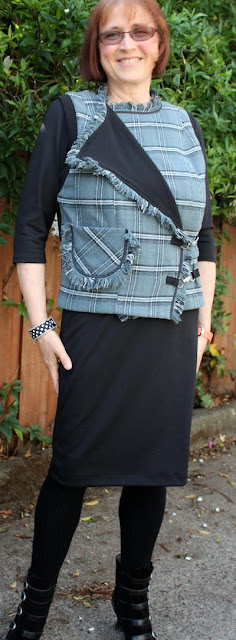
Welcome to Challenge #3 in the FabricMart Fabricista Fashion Challenge!
TOC:
Rules for Challenge 3
Challenge #2 was so much fun! Challenge #3 presented a different sort of challenge. Here are the rules:
Using the 6 yard Bundle we have sent you, make a 2 piece garment. What is in the bundle is a mystery and everyone will receive something different. Try to incorporate the three fabrics in some way. You can use fabric from your stash to finish your look, but keep in mind that the bundle fabric must make up a majority of your outfit. You will be judged on creativity, craftsmanship, the way you use your fabrics together, and fit.
Materials
I received the following three fabrics (clicking the pic takes you to the link on the FabricMart site):
- Gray plaid flannel, 2.5 yards.

- Black poly/cotton ponte, 2 yards (though it was actually more).

- Navy soft cotton print with tennis rackets, 1.5 yards.

In addition to these three fabrics, I added a few supplies:
- Strips of bias silk organza for making the fringe.
- Fusible tricot interfacing - used only in the back neck facing.
- Cotton twill tape sewn to the outer edge and the pocket edge.
- Two keyrings from the local hardware store - used as closures.
Bleaching the Fabric
I was pretty happy with the black ponte (I've sewn with loads of black ponte - it's right in my wheelhouse) and the gray plaid flannel, but the tennis rackets presented a challenge. While the navy tennis racket fabric was very smooth and soft, I didn't like how it looked alongside the homespun grey flannel. It just didn't work for me. I considered various options, including dyeing the tennis racket fabric to black, chopping it up - for example into bias strips, or using it (as is) as lining.
During my musings, I wondered how it might react to bleach. I rarely use bleach, but I had a container of liquid bleach in the laundry room that was very old, and half full. I first immersed a square of the tennis racket fabric in a 50/50 mix of bleach/water for 8 minutes. It lightened to a mauve color. The tennis rackets were still very evident, but the mauve color worked much better with the grey.
 Bleaching the yardage.
Bleaching the yardage.
 The water turned a berry color.
The water turned a berry color.
I used the remaining of the bottle of bleach, mixed with an equal-ish amount of water, on the entire piece of fabric, for 8 minutes. After rinsing, I ran it through a cycle in the washing machine and dryer. I can't say that I love the fabric, but the color feels more harmonious with the grey.
 The resulting fabric.
The resulting fabric.
What to do...
We received the 3rd challenge on Monday morning. I spent Monday evening trying to decide what to do with my three fabrics. At first I was thinking of using the black ponte for pants and some sort of top with the grey plaid - I'd even started choosing patterns. After thinking on this for awhile, I decided that it was a fairly predictable way to use the fabrics and I didn't want to be so predictable.
So, it was back to the drawing board. I decided that I wanted to make a moto-style vest and to pair it with a black ponte sheath dress with 3/4 length sleeves. Once this decision was made, I had a lot of fun planning the details of the moto vest, which uses all three fabrics: the plaid is on the front, the pocket, and the back neck facing. The black ponte is the back and the front facings and as the armhole ribbing. The tennis racket fabric lines the shell and the pocket.
Garment #1: Vest
I started with my TnT moto jacket pattern which I first made in July, the Eggplant Pleather Moto Jacket. For this version I made quite a few changes:
- Left off the sleeves.
- Omitted the collar.
- Shortened by 2".
- Did more fitting, especially through the hips. I took in about 6" at the hips between the side seams and the CB seam.
- Drafted a lined bias pocket.
- Made bias fringe and attached it around the outside edge of the vest. I also used it around the outside edge of the pocket.
- Hand sewed charcoal grey cotton twill tape around the outside edge of the vest and also around the outside edge of the pocket.
- Eliminated all zippers and used two keyrings as the closure.
- Cut back the armholes and finished with a ribbing made from the black ponte.
 Armhole ribbing. I love this technique as the ribbing pulls the armhole in close to the body.
Armhole ribbing. I love this technique as the ribbing pulls the armhole in close to the body.
The front of the jacket features princess seams. I wanted to match the plaid, but with a large bust alteration, you have the choice of matching the plaid either above the bust, or below, but not both. I chose to match below the bust, as I will usually wear this with the lapels open and that will mostly obscure the princess seams above the bust.
Bias Fringe
Three years ago I made a jacket using a Sandra Betzina pattern, Vogue 1036. As part of this project I made some bias fringe to insert into the seams. Bias fringe is different than regular fringe, as you start with bias strips of fabric and separate the threads to make the fringe. It is very time intensive.
Gwen, of the blog All My Seams (and who passed very recently) asked that I write a tutorial on how to create the fringe. You can see my page on Bias Fringe Technique. You can refer to the tutorial for the specifics, but here are some photos of this project.
For this vest, I made three strips of bias fringe. Two were about 24" long and the third was 36" long. The 24" strips took me about 2 hours each to fringe. The 36" strip took me about 3 hours. It was challenging to fringe the plaid flannel, especially once it had been washed. Flannel tends to "grab" itself and doesn't easily separate. This technique is easier with a boucle or a handwoven fabric.
 Cutting the 1.5" bias strips.
Cutting the 1.5" bias strips.
 The bias strips cut and pressed.
The bias strips cut and pressed.
 The fringe on the right is in process. It is wild and unkempt. The fringe on the left has been "groomed" and pinned to the front of the jacket.
The fringe on the right is in process. It is wild and unkempt. The fringe on the left has been "groomed" and pinned to the front of the jacket.
I didn't want the fringe to be overly heavy, so I only lightly trimmed any errant threads, leaving the rest to look a bit uneven and more organic.
After the fringe was inserted into the outer seam of the vest and the pocket, I wanted to add a bit of definition, so I hand sewed charcoal grey cotton twill tape to the outer edge of the jacket and to the pocket. I hand sewed each edge of the narrow twill tape. This step was also quite time intensive, but I enjoy hand sewing.


Bias Pocket
I have showcased zippers quite a bit recently, so I wanted to avoid zippers on this moto vest. I mulled over my pocket choices and decided to add a bias patch pocket with rounded edges. I also featured the bias fringe and the cotton twill tape around the pocket.




Keyring Closures
 Look Ma, It's Keyrings!!
Look Ma, It's Keyrings!!
 Auditioning the key rings, along with the bias fringe. The fringe on top is in process.
Auditioning the key rings, along with the bias fringe. The fringe on top is in process.
A few weeks ago I was in the local hardware store buying electrical wire. At the cash register, they have a display of keyrings, including caribiners. In the display was a silver-colored keyring that intrigued me. On each end of the keyring there is a round metal circle that can hold keys. If you trigger a little mechanism, which you push like a plunger, the larger keyring separates into two smaller keyrings, each with one ring. I was very excited by this keyring, though the guy at the cash register clearly thought I was odd, as his response to my exclamations over the cool mechanism was a dry, "We do what we can." I thought this keyring would make an interesting closure, so I bought one. I went back this week and bought a second one, as I wanted two for the vest.

To attach the keyring to the vest, I made 4 loops out of the black ponte and put one loop through each ring. I top-stitched the loops to the vest.
This may be my favorite part of the entire project.
Garment #2: Dress
For the dress worn under the vest, I used another TnT pattern. I first made the Marcy Tilton Shingle Dress last May. This time I omitted the shingles and made the under layer. I used 3/4 sleeves, the same as before. I made a few changes:
- Cut the neckline 2.5" lower in front.

- Used a regular necking binding, a la Sarah Veblen.
- I shortened the dress by 4".
- Hemmed the sleeves and the bottom. (The original dress had raw edges.) For this I used my coverstitch machine.
- Took in 8" (2" from each side seam) at the hips.

- Took in 2" (1" from the underarm sea) at the bottom of the sleeve.

- Omitted the shingles (as mentioned).
This dress sews up so quickly, especially if you leave off the shingles. It makes a great LBD!
I thought it might be interesting to show you the fitting I do which is typical for me. I first sewed up the dress as it came out of the envelope (after I'd done my vertical-only FBA, which I did the last time I made the dress. Here is how the dress looked after I'd sewn it up, but before I'd hemmed it or take it in:
 Before hemming or taking in the dress. You can see that it is designed for a Pear Shape, which I am not.
Before hemming or taking in the dress. You can see that it is designed for a Pear Shape, which I am not.
 After taking in the sleeve (2"), and the hips (8"), and taking up the hem (4").
After taking in the sleeve (2"), and the hips (8"), and taking up the hem (4").
Conclusion
I'm very pleased with this outfit! I am disappointed by how much the plaid fabric pilled with one trip through the washer/dryer, but I like the overall effect of the plaid moto vest. The dress will be a great basic and I might even cut off the neckline to make it a bit deeper and then replace with a new ribbing. The ponte washed and dried beautifully with no signs of pilling. But my favorite aspect is definitely the keyring closures!
More Pictures
 Worn open
Worn open
 Fully closed
Fully closed
 One lapel open
One lapel open
 Both lapels open
Both lapels open
 I like how the fringe stands up at the back neck!
I like how the fringe stands up at the back neck!
 Flashing the lining
Flashing the lining
Patterns




































